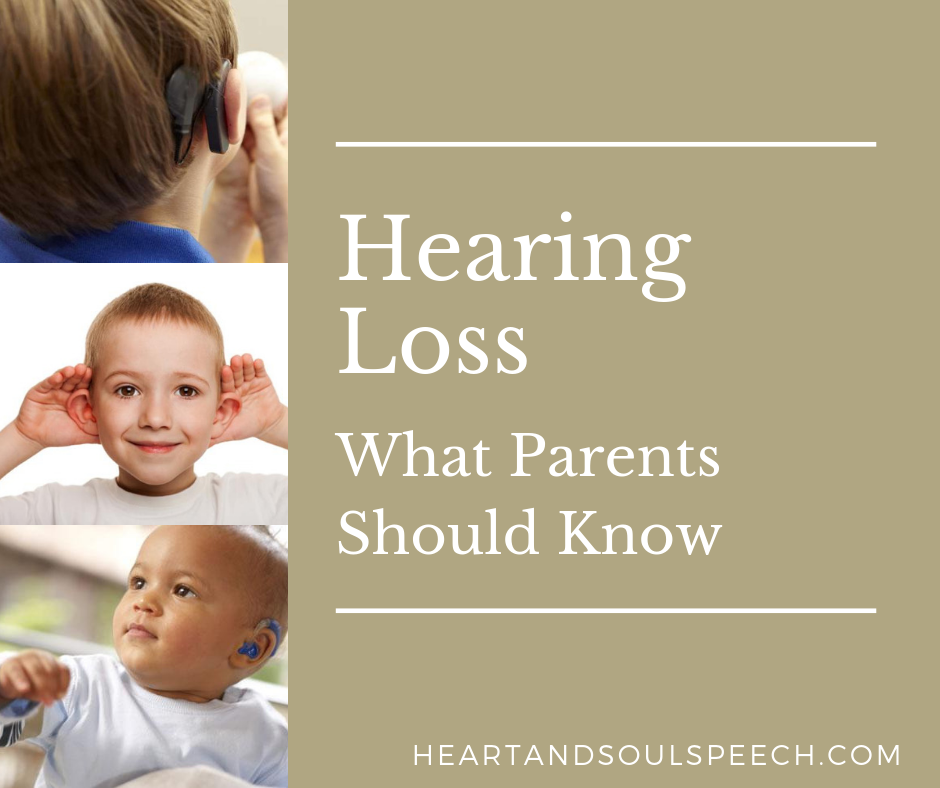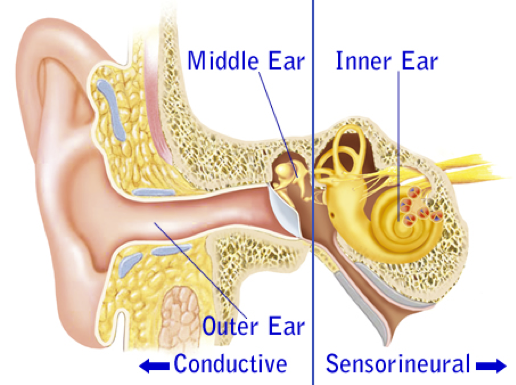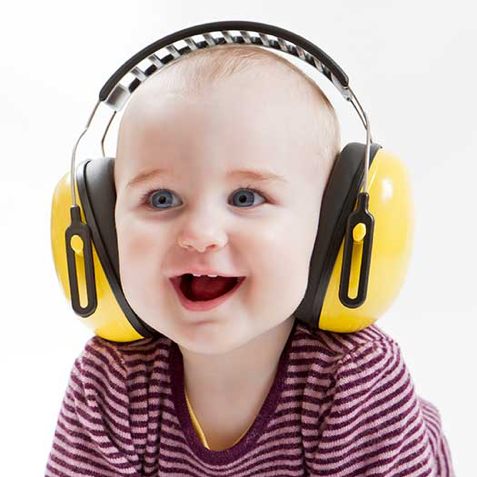
The ability to hear is extremely important for children when developing speech and language skills. An audiologist may provide evaluation and treatment of hearing loss, whereas a speech-language pathologist can offer treatment to improve speech/language in the presence of a hearing loss. Here’s what parents and caregivers should know about children’s hearing.
How common is hearing loss in children?
The Centers for Disease Control and Prevention (CDC) has indicated five out of every 1,000 children are impacted by hearing loss, and 1.7 newborns per 1,000 births are born with it.
Hearing loss is becoming more common in youth, unfortunately, due to environmental noise. The CDC estimated 14.9% of children and adolescents ages 6-19 have suffered permanent damage to their hearing due to excessive noise exposure.
What is Newborn Hearing Screening?
Newborn hearing screenings test if a child might have hearing loss. It is typically done on infants in the first 24-48 hours after birth. It is not painful and only takes a few minutes. Most babies sleep through the screening.
Early Hearing Detection and Intervention was created to screen every newborn for adequate hearing prior to hospital discharge. The goal is for infants who do not pass the screening to receive appropriate evaluation before 3 months of age and become enrolled in early intervention by six months of age when necessary.
 Credit: Utah Department of Health
Credit: Utah Department of Health
What causes hearing loss in children?
There are several possible causes of hearing loss in children–congenital, acquired, or transient.
Congenital Hearing Loss
Congenital hearing loss is present at birth, but is not always easily identified. Genetic factors cause more than 50% of all hearing loss in children, whether loss is present at birth or manifests later in life. Genetic factors that may cause congenital hearing loss include:
Autosomal recessive hearing loss
This is the most common type of genetic congenital hearing loss (70%). This means neither parent has a hearing loss, but each parent carries a recessive gene that gets passed to the child. A parent may not be aware they have the recessive gene.
Autosomal dominant hearing loss
This accounts for around 15% of genetic hearing loss, where one parent carries a dominant gene for hearing loss passes it to their child. The parent may or may not have hearing loss, but may have other signs of a genetic syndrome.
Genetic syndromes
This most often includes Usher syndrome, Treacher Collins syndrome, Waardenburg syndrome, Down syndrome, Crouzon syndrome, and Alport syndrome.
Idiopathic
Other times experts aren’t sure why an infant may be born with hearing loss. Non-genetic factors account for about 25% of congenital hearing loss. These possible causes of congenital hearing loss may include the following:
- Birth complications (rubella cytomegalovirus, toxoplasmosis, serious maternal infection, lack of oxygen, requirement of blood transfusion, etc.)
- Premature birth. Babies that are born weighing less than 3 pounds or require certain life-sustaining drugs for respiration are at a risk for hearing loss.
- A nervous system or brain disorder
- Use of ototoxic medication by the mother during pregnancy. Medication like various antibiotics and NSAIDS can potentially damage the developing auditory nerve or ear anatomy. Find a list of common ototoxic medications HERE.
- Maternal diabetes
- Drug or alcohol abuse by mother, or smoking during pregnancy
Acquired Hearing Loss
This applies to children who acquire hearing loss after birth. This may include:
- Ruptured eardrum
- Otosclerosis or Meniere’s disease, progressive disease
- Infection like meningitis, measles, mumps, whooping cough
- Taking ototoxic medications
- Traumatic brain injury
- Exposure to loud noise
- Untreated or frequent otitis media (ear infections)
- Exposure to secondhand smoke
Transient Hearing Loss
Transient or inconsistent hearing loss in children can also be detrimental to speech and language development. This can be caused by otitis media, more commonly known as middle ear infection. At least 75 percent of children have had one episode of otitis media by the time they are three years old. This type of infection is very common in children because of the Eustachian tube position during childhood. The Eustachian tube, which allows for air pressure equalization between the middle ear and the nasopharynx, is smaller and more horizontal during development. Thus, it is very susceptible to blockage by fluids or large adenoids.
Transient hearing loss due to an ear infection can occur when fluid inhibits the vibrations of the tiny middle ear bones, making efficient sound transmission difficult. Thankfully, this type of hearing loss is usually temporary and resolves itself. However, frequent, untreated middle ear infections can cause cumulative damage to the bones, eardrum or auditory nerve, creating a permanent, sensorineural hearing loss.
What are the different types of hearing loss?
- Conductive hearing loss may result in “muffled” sounds due to a hole in the eardrum, fluid in the middle ear, or an ear canal blocked by wax.
- Sensorineural hearing loss is usually permanent and best outcomes involve a hearing device. Children may report unclear voices, have unclear speech themselves, or mumble.
- Mixed hearing loss is the result of both conductive and sensorineural hearing loss and can be on only one ear, or both ears.

What are the signs of possible hearing loss?
The American Speech Language Hearing Association (ASHA) lists the following speech and language milestones that could be related to hearing loss. If you have concerns about your child’s hearing development, please call your pediatrician, audiologist, or speech-language pathologist.
From birth to four months, your infant should:
- Startle at loud sounds
- Wake up or stir at loud noises
- Respond to your voice by smiling or cooing
- Calm down at a familiar voice
From four months to nine months, your infant should:
- Smile when spoken to
- Notice toys that make sounds
- Turn its head toward familiar sounds
- Make babbling noises
- Understand hand motions like the bye-bye wave
From nine to 15 months, your infant should:
- Make various babbling sounds
- Repeat some simple sounds
- Understand basic requests
- Use its voice to get your attention
- Respond to name
From 15 to 24 months, your infant should:
- Use many simple words
- Point to body parts when you ask
- Name common objects
- Listen with interests to songs, rhymes and stories
- Point to familiar objects you name
- Follow basic commands
Older children could also acquire hearing loss that is either permanent or temporary. Here are some things to look for if you think your toddler or preschool-age child might have hearing loss:
- Has difficulty understanding what people are saying.
- Speaks differently than other children her or his age.
- Doesn’t reply when you call his or her name.
- Responds inappropriately to questions (misunderstands).
- Turns up the TV volume incredibly high or sits very close to the TV to hear.
- Has problems academically, especially if they weren’t present before.
- Has speech or language delays or problems articulating things.
- Watches others in order to imitate their actions, at home or in school.
- Complains of ear pain, earaches or noises.
- Cannot understand over the phone or switches ears frequently while talking on the phone.
- Says “what?” or “huh?” several times a day.
- Watches a speaker’s face very intently – many children’s hearing loss escapes detection because they are very successful lip readers.
How can treatment help?
Depending on the severity and cause of decreased hearing in your child, hearing aids, cochlear implants and a combination of speech therapy or assistive listening devices might be recommended forms of treatment. If your child has wax buildup or frequent ear infections, an audiologist or orolaryngologist (ENT physician) can help.
Hearing aids
Hearing aids are just one kind of device that can help children with hearing loss hear clearly again. There are many advanced models, including high-powered aids for children with profound hearing loss, that offer high-quality hearing assistance. Many solutions for children include special coverings and other accessories to ensure that young children don’t remove or misplace their hearing aids. There are several models of devices to choose from, including behind-the-ear hearing aids or those that are almost entirely in the ear canal and very discreet.
Cochlear implants
Cochlear implants are surgically implanted devices that directly stimulate the auditory nerve in the inner ear with electrical stimulation. They also have an external device, and many companies make kid-friendly devices that can be held on with a soft headband. These work well for infants and children who cannot benefit from hearing aids.
Speech therapy
If a child does not have consistent and clear access to hearing, it is likely their speech and language development will be influenced. For children who have had hearing loss that has affected their speech, he or she might need speech-language therapy after getting hearing aids or a cochlear implant to help him or her catch up on speech delays. There are different methods of communication, ranging from auditory listening to visual sign language or a combination of both. The speech-language pathologist will help your family implement the best communication method for your family and child. Regardless of the communication method, it is important children are able to express their needs and feelings in a way others understand.
Assistive listening devices
Many hearing aid manufacturing companies offer assistive listening devices such as FM systems that are discreet and work well in a classroom situation in conjunction with the child’s hearing aid or cochlear implant. FM technology helps overcome the poor acoustics of classroom settings or other venues with lots of background noise. Essentially, the teacher wears or has a discreet microphone in front of him or her that transmits his or her voice directly to the child’s hearing aids or cochlear implant.
When should treatment start?
Research has shown detection and intervention for hearing loss prior to six months of age results in significantly better outcomes than intervention after six months of age. There are ways to test hearing for very young children or those who cannot participate in traditional testing procedures. The earlier intervention is provided, the better the outcomes could be.
How can I protect my child’s hearing from noise exposure?
With the alarming rate of youth experiencing hearing loss from environmental exposure and excessive noise, it is more important than ever to protect small ears and brains. Young infants and children can protect their hearing by wearing headphones like the picture below. If you can hear your child’s music or TV from their headphones, it’s too loud. Some devices may have volume limits you can set. For more information, click on the links below.
https://www.babyhearing.org/protect-hearing
https://www.noisyplanet.nidcd.nih.gov
https://www.asha.org/public/hearing/Noise-and-Hearing-Loss-Prevention/

What supports are available for parents of children with hearing loss?
https://www.asha.org/public/hearing/Hearing-Loss-in-Children/
https://www.cdc.gov/ncbddd/hearingloss/parentsguide/resources/index.html
https://www.babyhearing.org/parenting/raising-child-who-is-deaf-or-hard-of-hearing
https://www.mydeafchild.org/resources
